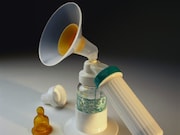Pumped milk is associated with the depletion of oral bacteria, higher abundance of potential pathogens
THURSDAY, Feb. 14, 2019 (HealthDay News) — Compared with direct breastfeeding, indirect breastfeeding with pumped milk is associated with the depletion of oral bacteria and a higher abundance of potential pathogens, according to a study published in the Feb. 13 issue of Cell Host & Microbe.
Shirin Moossavi, M.D., from the University of Manitoba in Winnipeg, Canada, and colleagues assessed the composition and determinants of milk microbiota from 393 mother-infant dyads participating in the Canadian Healthy Infant Longitudinal Development (CHILD) cohort study.
The researchers found that milk microbiota at three to four months postpartum exhibited discrete compositional patterns and was dominated by inversely correlated Proteobacteria and Firmicutes. Maternal factors (body mass index, parity, and mode of delivery) and breastfeeding practices were associated with milk microbiota composition and diversity in a sex-specific way. Direct breastfeeding was associated with microbes typically found in the mouth as well as higher overall bacterial richness and diversity. Pumped breast milk was consistently associated with enrichment of potential pathogens and depletion of Bifidobacteria.
“Contrary or in addition to the hypothesis that milk bacteria come from the mother’s gut, our results suggest that the infant’s oral bacteria are important in shaping the milk microbiota,” a coauthor said in a statement.
Copyright © 2019 HealthDay. All rights reserved.








